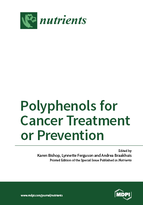Polyphenols for Cancer Treatment or Prevention
A special issue of Nutrients (ISSN 2072-6643).
Deadline for manuscript submissions: closed (15 July 2016) | Viewed by 312309
Special Issue Editors
Interests: cancer risk/progression modified by nutrition; gene–diet interactions; dietary interventions; medicinal mushrooms; characteristics of heritage tangerine tomatoes
Special Issues, Collections and Topics in MDPI journals
Interests: nutrigenetics; nutrigenomics; nutrigenomics technologies; genetic toxicology; DNA damage and repair; environmental mutagenesis; environmental carcinogenesis; mechanisms of anticancer drug action; gene–diet interactions—particularly in prostate and colorectal cancer; inflammatory bowel disease and other inflammation-related disorders
Special Issues, Collections and Topics in MDPI journals
Interests: antioxidants; natural bioactives; muscle adaptation; aerobic capacity; visual function; food patterns; Mediterranean diet; polyphenols; chronic disease
Special Issue Information
Dear Colleagues,
Polyphenols are commonly found in fruits and vegetables, and have been suggested to have protective effects against chronic diseases, such as cancers. They are a diverse group of molecules, many of which possess antioxidant, anti-inflammatory, epigenetic, drug sensitization, and/or modulation of xenobiotic metabolizing enzyme properties. However, there is mixed evidence regarding their protective effects with respect to various cancers. Some of this controversy may be due to the combination of polyphenols administered, synergistic effects of accompanying compounds, bio-accessibility, bioavailability, effect of gut microbiota, and the type of cancer investigated. The purpose of this Special Issue is to present the recent evidence for the effect of polyphenol intake on cancer, as well as mechanisms of action. This Special Issue, entitled "Polyphenols for Cancer Treatment or Prevention", welcomes manuscript submissions of original research, meta-analyses, or reviews of the scientific literature. Authors should focus their manuscripts on polyphenol bioactives or dietary patterns naturally rich in polyphenols that have been identified and used for the prevention and or treatment of cancer.
Dr. Karen Bishop
Prof. Lynnette Ferguson
Dr. Andrea Braakhuis
Guest Editors
Manuscript Submission Information
Manuscripts should be submitted online at www.mdpi.com by registering and logging in to this website. Once you are registered, click here to go to the submission form. Manuscripts can be submitted until the deadline. All submissions that pass pre-check are peer-reviewed. Accepted papers will be published continuously in the journal (as soon as accepted) and will be listed together on the special issue website. Research articles, review articles as well as short communications are invited. For planned papers, a title and short abstract (about 100 words) can be sent to the Editorial Office for announcement on this website.
Submitted manuscripts should not have been published previously, nor be under consideration for publication elsewhere (except conference proceedings papers). All manuscripts are thoroughly refereed through a single-blind peer-review process. A guide for authors and other relevant information for submission of manuscripts is available on the Instructions for Authors page. Nutrients is an international peer-reviewed open access semimonthly journal published by MDPI.
Please visit the Instructions for Authors page before submitting a manuscript. The Article Processing Charge (APC) for publication in this open access journal is 2900 CHF (Swiss Francs). Submitted papers should be well formatted and use good English. Authors may use MDPI's English editing service prior to publication or during author revisions.
Keywords
- Polyphenols (dietary)
- cancer prevention
- cancer treatment
- diet
- DNA damage
- DNA repair
- Microbiota
- synergistic effects
- bio-accessibility
- bio-availability









